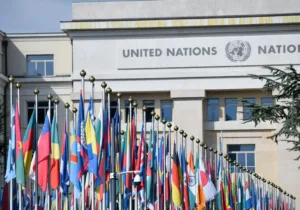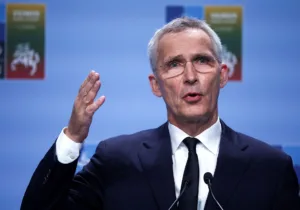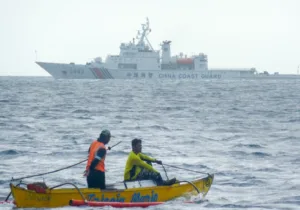Prime Minister Shinzo Abe’s reelection as the president of the Liberal Democratic Party has given him three more years in power, all but guaranteeing he will become Japan’s longest-serving leader ever. Given the surprisingly strong challenge from his longtime rival former Minister Shigeru Ishiba, Abe has promised this will be his final term and that he will govern “carefully” and “humbly,” implicitly acknowledging the scandals that have plagued his administration this year. To some observers, Abe’s reelection is a moment of celebration for a country that had one of the most notorious rotating prime ministerships in the world that made foreign policy and global leadership almost impossible for Tokyo. However, there is also ambivalence in Tokyo about what—or who—comes next. Here are the three things to watch for and pay attention to after Prime Minister Abe’s reelection:
Abe’s Leadership & Legacy
Under Abe, a centralized national security council was created, and a strong prime ministership has made Japan an island of stability among democracies, which are being swept up in populist movements, and has guaranteed much-needed continuity for an aging population. Abe’s legacy as a global statesman will be burnished over the next few years as he hosts the G20 next year in Osaka and the Tokyo Olympics in 2020, putting Japan on the global stage in a way it has traditionally not been on, at least not alone.
Prime Minister Abe just met with Presidents Vladimir Putin and Xi Jinping on the sidelines of the largest joint Russian-Chinese military exercises with America paying little attention when it traditionally would have protested. Instead, thanks to America’s increasingly protectionist stance that has led to a vacuum in geo-economic and geopolitical terms, Abe is poised to reap the benefits of this new global opportunity along with the obvious risks.
Relationship with Trump & the US
Now on the back of his election victory, Abe has headed to New York for the UN General Assembly, where he met with President Trump. His summit with Trump will be one of the most consequential, given the US has threatened Japanese carmakers with tariffs, which are based on highly unusual national security grounds for a longtime ally and no longer seem like posturing on the part of Washington. Clearly, Trump believes that this strong protectionist stand is necessary in advance of the upcoming midterm elections. Abe’s bromance with Trump may have reached a turning point because of Washington’s aggressive stance and Abe’s relative freedom to maneuver as he heads to China immediately afterward for a summit with Xi.
Abe has expanded what the Japanese thought was possible on the global stage from the unprecedented number of foreign trips he has taken, international initiatives he has joined, and the way he has mobilized industry to make Japan a real geo-economic power. As prime minister, Abe has turned previous assumptions in Japan on their head by making foreign travel a mainstay of his leadership as he has cultivated strong relationships with many of the world’s strong leaders—including not just Trump but also Putin, Xi, Tayyip Erdogan, Narendra Modi, Benjamin Netanyahu, and many more—in his unprecedented globetrotting that has made him a mainstay of the G7 and G20, which he will host next year in Osaka. The Free and Open Indo-Pacific strategy that the Trump administration has adopted as its own has its roots in Japanese foreign policy, and Abe has been a champion of further globalizing the US-Japan alliance. Finally, Abe hopes to avoid a collision with his closest international ally by focusing on the shared geo-economic, geo-technological, and geopolitical interests that Japan has with America in order to placate Trump in advance of his own midterm election in November.
What Comes Next?
Given the geopolitical stakes, Abe’s steady hand and leadership are valued far beyond Japan, yet the Japanese can’t help but worry about what comes next. Now that Abe can switch to legacy mode, a potentially bold move might be to cultivate the next generation for leadership without regard to the traditional waiting periods. Without a clear succession plan, much of the next three years will be consumed by domestic politics and internal divisions. The conventional wisdom is that without a strong bench or succession plan post-Abe, Japan will go back to the one-year rotations of prime ministers, which would be a huge loss not just for Tokyo but also Washington, Brussels, and beyond.
As one of the oldest nations in the world, Japan could benefit from its own youthful “Macron” moment to energize the world’s third-largest economy. Shinjiro Koizumi, the son of former Prime Minister Junichiro Koizumi, is the most obvious face to put forward. But there are others who could benefit from Abe’s mentorship and steady hand in the next three years rather than an ugly internal power struggle in the LDP. The fact that Abe will host the G20 in the same year that French President Emmanuel Macron, who emerged on the political scene with less experience than his traditional competitors, will host the G7 has not been lost on many here. Given that liberal societies and international order are in retreat and under increasing populist attack in the US, Britain, and any number of other European nations, Abe has a rare political mandate and will to be a champion who can continue to globalize the US-Japan alliance, even as a new type of thinking in Washington and Tokyo reshapes the alliance. Abe has a unique role to play as President Trump’s last remaining close democratic international ally while heading into a hostile environment at the UN.
—
Joshua W. Walker, PhD (@drjwalk) is Global Head of Strategic Initiatives and Japan at Eurasia Group, the world’s leading geopolitical risk consultancy, and a fellow at the German Marshall Fund’s Asia Program focused on Japan.
Photo Credit: Japanese Prime Minister Shinzō Abe and President Donald Trump showing “Donald & Shinzo – Make Alliance Even Greater” caps in November 2017. Via Wikimedia Commons.






